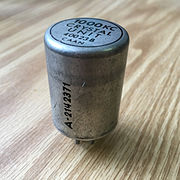The Modern Term Hertz Means

The cycle per 2nd was a once-mutual English name for the unit of frequency now known as the hertz (Hz). The plural form was typically used, frequently written cycles per second, cycles/2d, c.p.s., c/southward, or, ambiguously, just cycles (Cy./Cyc.). The term comes from the fact that sound waves have a frequency measurable in their number of oscillations, or cycles, per second.[1]
With the organization of the International System of Units in 1960, the bike per second was officially replaced by the hertz, or reciprocal second, "s−1" or "1/s". Symbolically, "bicycle per 2nd" units are "cycle/second", while hertz is "Hz" or "s−1".[two] For college frequencies, kilocycles (kc), equally an abbreviation of kilocycles per second were often used on components or devices. Other higher units like megacycle (Mc) and less commonly kilomegacycle (kMc) were used before 1960[3] and in some later documents.[four] These take modern equivalents such as kilohertz (kHz), megahertz (MHz), and gigahertz (GHz). Following the introduction of the SI standard, use of these terms began to fall off in favor of the new unit, with hertz becoming the dominant convention in both bookish and colloquial speech by the 1970s.[5]
The rate at which aperiodic or stochastic events occur may exist expressed in becquerels (as in the example of radioactive decay), not hertz, since although the two are mathematically like, by convention hertz implies regularity where becquerels implies the requirement of a time averaging operation. Thus, one becquerel is one issue per second on average, whereas ane hertz is ane consequence per second on a regular cycle.[two]
Wheel tin too be a unit for measuring usage of reciprocating machines, particularly presses, in which cases cycle refers to one complete revolution of the mechanism being measured (i.e. the shaft of a reciprocating engine).
Derived units include cycles per mean solar day (cpd) and cycles per year (cpy).
See also [edit]

Crystal resonators, the 1940s-era middle unit is marked in kc.
- Cycles per instruction (CPI)
- Heinrich Hertz
- Instructions per bike (IPC)
- Instructions per second (IPS)
- MKS system of units a predecessor of the SI set up of units
- Normalized frequency
- Radian per 2d
- Revolutions per minute (RPM)
- Plough (bending)
References [edit]
- ^ Ewbank, Henry Lee; Lawton, Sherman Paxton (1940). Projects for Radio Oral communication: A Manual for the Educatee . New York: Harper & Brothers. p. 151.
- ^ a b Taylor, Barry N.; Thompson, Ambler, eds. (2008). International System of Units (SI) (PDF). Special Publication. Vol. 330 (2008 ed.). Gaithersburg, Medico: National Plant of Standards and Technology. p. 27. Retrieved 2019-09-02 .
- ^ Grammar, George (January 1933). "Rationalizing the Autodyne". QST. West Hartford, CN: American Radio Relay, Inc. XVII (ane): eleven. Retrieved 2019-09-02 .
The 7000- and 14,000-kc. grid coils are wound with No. 18 enameled wire...
- ^ Guentzler, Ronald E. (April 1967). "The "Monode" Racket Generator". QST. West Hartford, CN: American Radio Relay, Inc. LI (2): xxx. Retrieved 2019-09-02 .
The Monode described here is usable at frequencies below 144 Mc. with slight modification.
- ^ "Kilocycle, Kilohertz, Megacycle, Megahertz". Google Ngram Viewer. 2020-07-03.
The Modern Term Hertz Means,
Source: https://en.wikipedia.org/wiki/Cycle_per_second
Posted by: quanwhouners.blogspot.com


0 Response to "The Modern Term Hertz Means"
Post a Comment